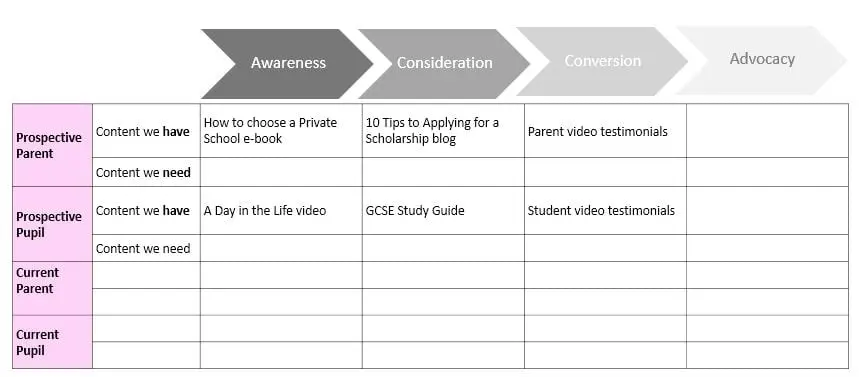Creating Your Schools Digital Marketing Strategy
JUN 03 2019
Having a digital marketing strategy in place as part of your school’s overall marketing plan is crucial. A good digital strategy should be well informed, targeted and focused, but also realistic. But where do you begin and what do you include?
Determine Your School Marketing Objectives
A good understanding of your school’s objectives is the first step in creating an effective digital marketing strategy. Without knowing what you’re aiming for, chances are you won’t hit it. Make your goals as specific as possible. Create SMART goals (see example below) and indicate the strategies you’ll use to achieve them and the KPIs you’ll use to measure your success.
In order to measure improvements in your digital marketing, you’ll need to first start with your historical data. If you don’t already have Google Analytics on your school website, do that done now. Google Analytics reporting will not only give you insight into how you’re school is being found, who your audience is and how they’re engaging with your website, it can also track and provide valuable insight on how you’re achieving your marketing goals.
| ADMISSIONS FUNNEL STAGE | SMART GOALS (12 MONTHS) |
STRATEGIES TO ACHIEVE GOALS |
KEY PERFORMANCE INDICATORS (KPIs) |
| Awareness: Increase brand awareness | Increase website visits by X% | Create a resource centre with content that is relevant to parents and pupils | New organic site visits, New Visitors, non-branded keyword searches |
| Interest: Increase engagement with content | Increase social media engagement by X% | Create more videos and animated gifs | Retweets, Likes, new Followers |
| Increase Open Day registration by X each event | Create tracking code to determine best converting campaigns | Page visits, Open Day registration numbers | |
| Decision: Increase conversion rates | Increase Admission numbers by X | Testimonials campaign – web, print and video | Admission numbers |
| Social Media advertising – testimonials | |||
| Advocacy: Increase long term advocates | Gather X testimonials from parents & pupils over the course of the year | Provide an area on website for easy submission | Testimonial numbers |
Identify Your Target Audiences
A successful digital marketing strategy also relies heavily on understanding your ideal customers. In most schools’ case that is parents, pupils and alumni. If you don’t know what your customers’ issues/concerns are, where they can be found, or what motivates their purchasing decisions (in this case their education), you can’t effectively sell to them. Ensuring that you understand the persona of your ideal customers is the first step.
Create ‘Persona Profiles’ by gathering as much data as you can about your target audience. The more you know about your ideal customers, the better you will be able to develop the marketing messages that speak directly to them. If you’ve set up goals in Google Analytics you’ll be able to quickly see who your converters are (i.e. those registering for your Open Day, filling out your online Admissions applications), their gender, age and even the keywords they’re using to find your school website. Download Hubspot’s free Persona Profile templates to organise your profiles.
Now that you’ve got your objectives and your audience identified you can begin to create your strategy. Although each school will be different, there are four main areas to consider when forming your digital marketing strategy:
1. Content
Great content is an essential foundation for both your website SEO and your school’s social media strategy. Creating a calendar of monthly topics will not only give you an opportunity to showcase your school’s unique story and differentiate yourself from other schools, but it can also bring you a steady stream of loyal followers. Remember however to keep your SMART goals and your Persona pains and considerations in mind when creating your content. Content can be very time consuming so make sure you have a strategy behind it. Consider a content audit to identify missing gaps in your admissions funnel. Don’t forget your current parents and pupils!

2. Social Media
If content is the backbone of a marketing plan, then social media should be thought of as one of the engines that help drive it. But don’t just do it for the sake of it. Decide on the social media platforms that best suit your abilities and will best reach your audience. Once you’ve determined your platforms, create a social media calendar to ensure you’re delivering the right messages, to the right people, at the right time. Start with the funnel content you’re creating for your website and build from there. Just like with your content, ensure you have a social media strategy and a way to measure your KPIs. When used properly, Google Analytics will allow you to track which social platforms, and even which social posts, are driving your website conversions. Another good reason to be looking at your data!
3. Advertising
School advertising once relied heavily on print, however with more parents and pupils online than ever before, digital marketing has now taken the lead and cannot be ignored. Keep this – and your Persona Profiles – in mind when developing your advertising plan. Know your audience. In order to effectively target your audience in either social media or PPC advertising (Pay Per Click), you’ll want to know their age, gender, where they go online and what their interests are. Consider as well options such as ‘lookalike’ audiences both in social and Google’s PPC adverts to target those that look like your current parents. Don’t forget to set up your Google Analytics conversion goals so you can accurately measure which advertising channels are working the best for you. Remember as well, just because you’ve tried PPC or social advertising once and it ‘didn’t work’, don’t give up. It’s a learning curve. Perhaps it wasn’t the right time or the right message. Measure, analyse and improve with each campaign. If you haven’t tried PPC advertising before, now might be the time to give it a try. With so few schools using it, the cost is much less than you might expect!
4. School Website
Your website is by far your biggest advertising platform so your school website strategy should not be taken lightly. Does your website talk to your Personas? Have you considered their journey? If a redesign is on your agenda are you clear about your desired branding, messaging, and your school’s unique value proposition? A new visitor to your website should immediately get a sense of what your school stands for, what you have to offer and what makes you different from all the other schools. From responsive design to protecting your valuable search engine optimisation, there is a lot to keep in mind when building a new website. Don’t try to rush it. Find a provider that you can trust that will look at the bigger picture and anticipate your future growth. And most importantly make sure you have the ability to easily update your school website yourself. Digital is moving rapidly—you need to be equally as responsive.
Putting it all Together
Although each school’s digital marketing strategy will be unique, there are some fundamental steps that will apply to all of you:
- Have a clear understanding of your marketing objectives
- Research your audience – create your Persona Profiles
- Implement your plans – use a calendar to keep you organised
- Learn and evolve – monitor your results and modify if necessary
Keep the above in mind when creating your school’s digital marketing strategy. For additional guidance or one-on-one support, just reach out!


